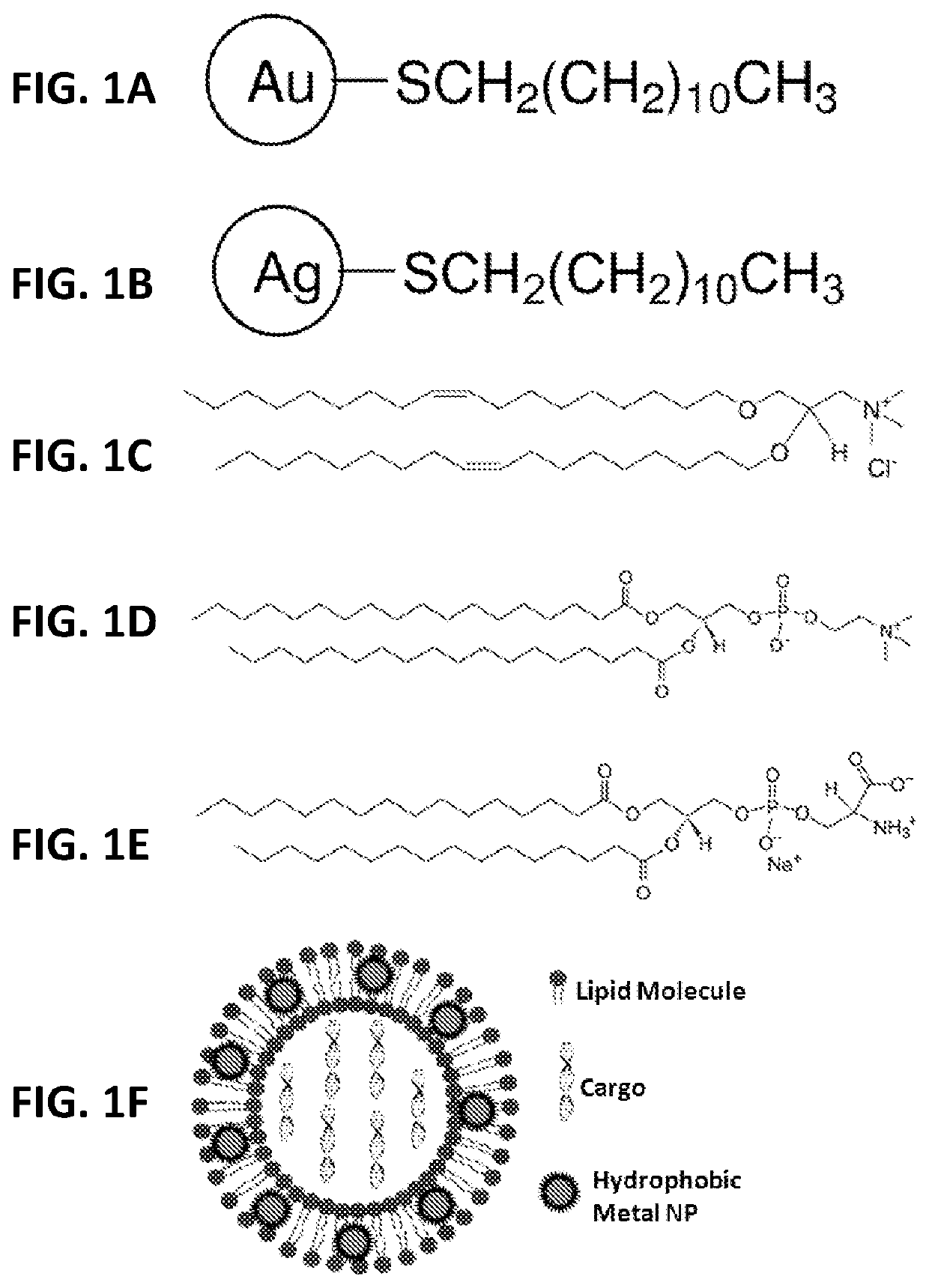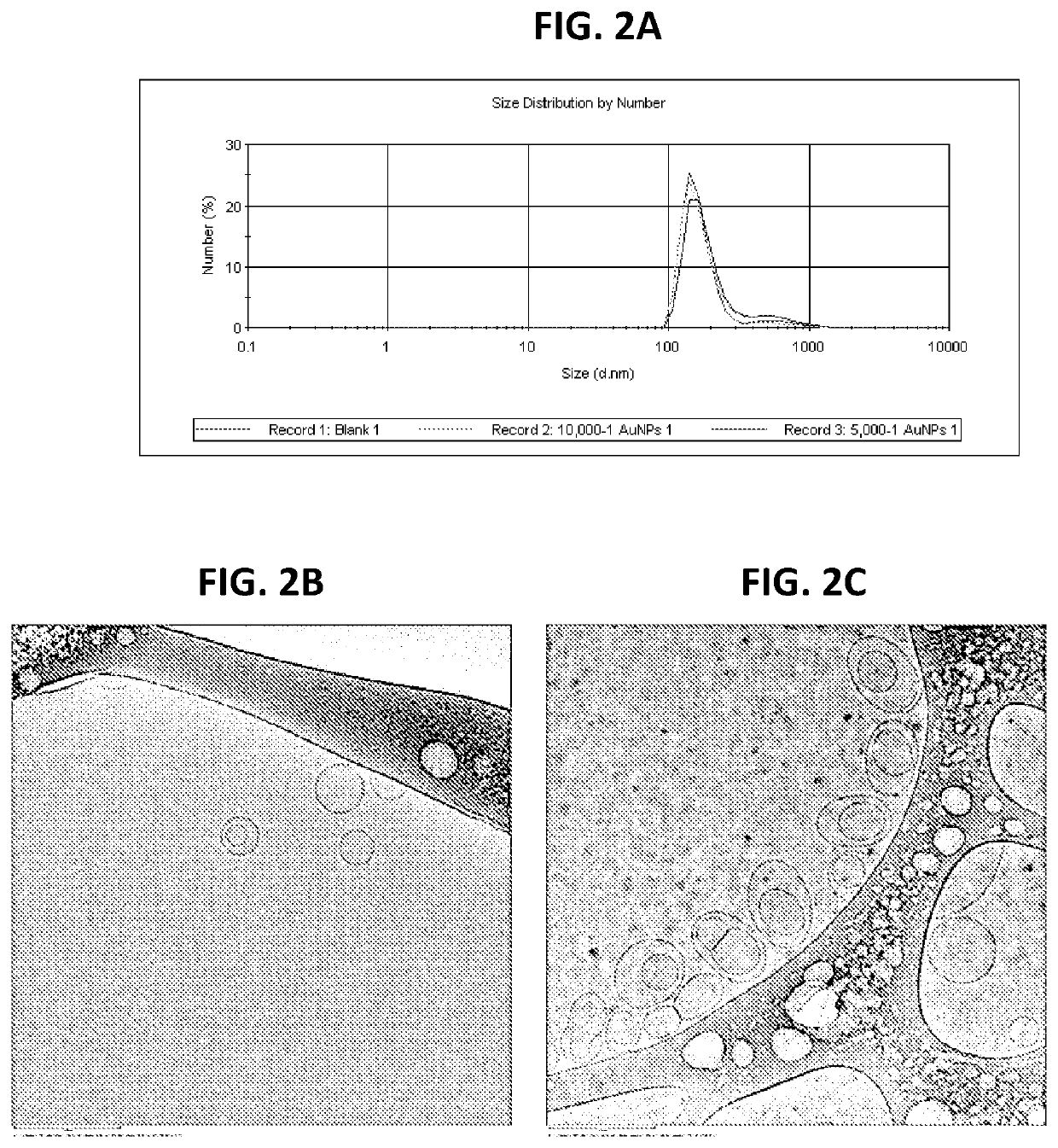Nanoparticle-induced fusogenicity between liposome and endosome membranes for targeted delivery through endosomal escape
a technology of endosomal escape and liposome, which is applied in the direction of organic active ingredients, biochemistry apparatus and processes, organic non-active ingredients, etc., can solve the problems of endosomal uptake pathway, the most rate-limiting step of expression of biological activity and ultimate development, and the effective pharmaceutical formulation and targeted delivery of these agents remains a significant challenge, and achieves the effect of high polynucleotide transfection efficiency
- Summary
- Abstract
- Description
- Claims
- Application Information
AI Technical Summary
Benefits of technology
Problems solved by technology
Method used
Image
Examples
example 1
[0035]As shown in FIG. 1, numerous hydrophobic NPs, such as gold and silver NPs coated with various hydrophobic materials, such as dodecanthiol (commercially available from nanoComposix (San Diego, Calif., USA) with a diverse size range, including NPs with a mean diameter of 2, 4, and 5 nm, were incorporated into the bilayers of liposomes comprising: (a) a nucleic acid (e.g., pDNA or siRNA molecules) and perhaps other active agents encapsulated in the hydrophilic core; (b) a cationic lipid (e.g., DOTMA) comprising from about 50 mol % to about 100 mol % of the total lipid present in the liposome; and (c) a non-cationic lipid (e.g., DSPC) comprising from about 0.01 mol % to about 50 mol % of the total lipid present in the liposome. While the range of nanoparticles useful for practicing the present invention generally range from about 0.1 nm to about 20 nm in average diameter, a preferred range of average diameter is between about 0.1 nm to about 5 nm.
[0036]In one embodiment, liposomes...
example 2
[0038]In another embodiment, MLVs were prepared by a thin film hydration method in order to study membrane fusogenicity enhancement induced by the inclusion of NPs in the membranes of these vesicles. Briefly, chloroform solutions of the cationic lipid DOTMA and the anionic lipid DPPS at an equimolar ratio with or without hydrophobic NPs at 10,000:1 or 5,000:1 (lipid molecules v. NPs) ratios were prepared in sterile glass vials. Thin uniform films were then prepared by rapidly evaporating the chloroform under vacuum for 2 hours at 25° C. in order to remove the trace solvent impurities. This film was then hydrated using an appropriate volume of citrate buffer (pH 4.5) in 10% D2O by vortexing for 30 seconds. The total lipid concentration in the resulting aqueous dispersion was 15 mM. The dispersion was then sonicated using a bath sonicator for 30 minutes. The morphology of the liposomes was assessed using cryo-TEM (JEM-2100F, Jeol USA Inc., MA, USA) and the phase transition was detecte...
example 3
[0039]In another embodiment, liposomes were prepared using a thin film hydration method. Briefly, a chloroform solution of the cationic lipid DOTMA and the non-ionic lipid DSPC at an equimolar ratio both with and without hydrophobic NPs at 10,000:1 (lipid molecules v. NPs) ratio was prepared in a sterile glass vial. A thin uniform film was then prepared by rapidly evaporating the chloroform under vacuum for 2 hours at 25° C. in order to remove the solvent. This film was then hydrated using an appropriate volume of phosphate buffered saline with / without comprising nucleic acid (pDNA) by vortexing for 30 seconds. The resulting dispersion was then sonicated using a bath sonicator for 30 minutes. The total lipid and pDNA concentrations in the liposomes were 2 mM and 40 ng / μl, respectively.
PUM
| Property | Measurement | Unit |
|---|---|---|
| phase transition temperature | aaaaa | aaaaa |
| mol % | aaaaa | aaaaa |
| mol % | aaaaa | aaaaa |
Abstract
Description
Claims
Application Information
 Login to View More
Login to View More - R&D
- Intellectual Property
- Life Sciences
- Materials
- Tech Scout
- Unparalleled Data Quality
- Higher Quality Content
- 60% Fewer Hallucinations
Browse by: Latest US Patents, China's latest patents, Technical Efficacy Thesaurus, Application Domain, Technology Topic, Popular Technical Reports.
© 2025 PatSnap. All rights reserved.Legal|Privacy policy|Modern Slavery Act Transparency Statement|Sitemap|About US| Contact US: help@patsnap.com



